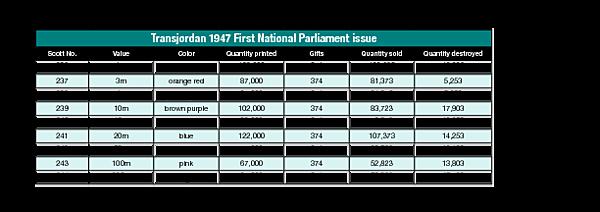World Stamps
1947 stamps honor Transjordan’s first national Parliament
To celebrate the inauguration of the first national Parliament of Transjordan on Nov. 1, 1947, the government issued a set of nine commemorative stamps (Jordan Scott 236-244).
In the grade of very fine, a mint, never-hinged set retails for $6.95, and a used set is listed at $4 in the 2015 Scott Standard Postage Stamp Catalogue.
This set can be found easily, either mint or used. The challenge is to find it on commercial cover.
When searching for what subject to portray on the stamps, it was decided to showcase the new government home in the capital, Amman.
All the stamps feature the same central design by Yacoub Sukkar depicting a front view of the Parliament building with a two-line Arabic text below it that translates: “To Commemorate the Founding of the Parliament” with the Gregorian and lunar years “1947” and “1366.”
An ornamental frame surrounds the central design. The name of the country in Arabic, “The Hashemite Kingdom of Jordan,” appears in the top center of the frame. In the bottom center of the frame is the name of the country in English, “Trans-Jordan.”
On the left side of the frame is the word “POSTAGE,” with the same in Arabic at right; both words are reading down.
Inscribed in the two bottom corners are the denomination and currency, in Arabic at right and in English at left. The royal crown is shown in the upper corners.
The British firm Thomas De La Rue & Co. printed the stamps on white unwatermarked paper in sheets of 50. The stamps were perforated gauge 12.
The denominations of the nine stamps range from 1 mil to 200m. In 1930, 1,000m equaled 1 Palestine pound.
In 1951, the country’s currency changed to fils and dinar; 1,000f equals 1d. Today, 1d is the equivalent of $1.41.
The nine denominations are listed in the accompanying table along with their colors and the quantities printed, sold, given as gifts and destroyed.
A total of 374 sets were given as gifts to members of the Universal Postal Union.
The quantities printed include 2,000 imperforate sets. It has been the belief that these imperforate stamps were given as souvenirs. This is not true. They were sold at face value exclusively to stamp dealers, collectors and anyone who bought in bulk.
Today, these imperforate stamps can be found as singles, pairs and blocks of four.
For mint, never-hinged stamps, a set in singles sells for about $25, a set in pairs can cost around $75, and a set in blocks of four can cost a little more than $200.
The entire set can be found overprinted with the word “SPECIMEN.” The quantity with this overprint is not known.
Only the 3m denomination is known with the word “SPECIMEN” perforated in the shape of a horseshoe; two sheets are thought to exist. One sheet has been broken up, and the other sheet is believed to remain intact.
Construction on the Parliament building began in 1946. The cost of this venture was funded by local businessmen, with the help and support of the British Council.
However, the price tag for the project was underestimated. Low contributions and the decline in trade with Palestine resulted in less money than what was needed.
As a result, the government of Transjordan agreed to step in and pay for the completion of the building in exchange for a five-year tenure in it. With the help of the government, the first National Parliament opened as scheduled.
A new Parliament building was completed in 1980.
MORE RELATED ARTICLES
Headlines
-
World Stamps
Oct 8, 2024, 12 PMPostcrossing meetup Oct. 9 at U.N. headquarters
-
Postal Updates
Oct 7, 2024, 5 PMUSPS plans to raise postal rates five times in next three years
-
US Stamps
Oct 7, 2024, 3 PMMcMurtrie dismissed as APS education director following Sept. 21 arrest
-
US Stamps
Oct 7, 2024, 12 PMVasiliauskas named president of Mystic Stamp Co.







